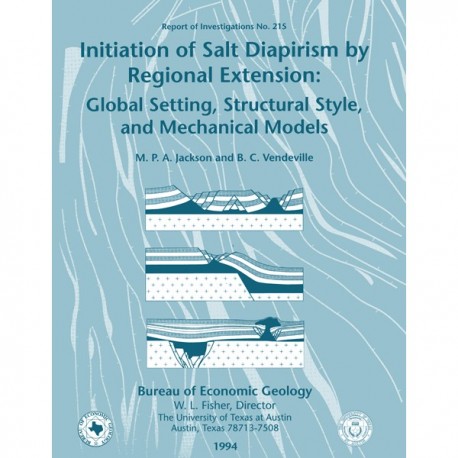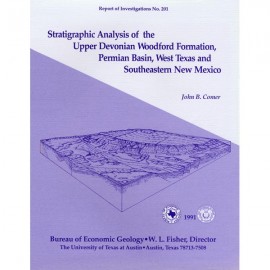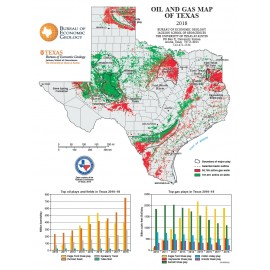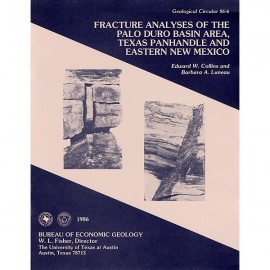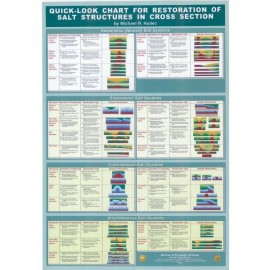Reports of Investigations
-
Books & Reports
- Reports of Investigations
- Guidebooks
- Udden Series
- Geological Circulars
- Down To Earth
- Atlases of Major Oil and Gas Reservoirs
- Texas Memorial Museum Publications
- Environmental Geologic Atlas of the Texas Coastal Zone
- Mineral Resource Circulars
- Other Reports
- Seminars and Workshops
- Handbooks
- Submerged Lands of Texas
- Symposia
- Annual Reports
- Open File Reports
-
Maps & Cross Sections
- Thematic Maps
- Miscellaneous Maps, Charts & Sections
- Geologic Atlas of Texas
- STATEMAP Project Maps
- Geologic Quadrangle Maps
- Cross Sections
- Highway Geology Map
- Energy and Mineral Resource Maps
- Shoreline Change and Other Posters
- Wilcox Group, East Texas, Geological / Hydrological Folios
- Bouguer Gravity Atlas of Texas
- River Basin Regional Studies
- Featured Maps
- Posters
- Teachers & the Public
-
Geological Society Publications
- Gulf Coast Association of Geological Societies
- Alabama Geological Society
- Austin Geological Society
- Corpus Christi Geological Society
- Houston Geological Society
- Lafayette Geological Society
- Mississippi Geological Society
- New Orleans Geological Society
- South Texas Geological Society
- GCS SEPM Publications
- Historic BEG & UT Series
Initiation of Salt Diapirism by Regional Extension: Global Setting, Structural Style, and Mechanical Models
RI0215
For a downloadable, digital version: RI0215D.
RI0215. Initiation of Salt Diapirism by Regional Extension: Global Setting, Structural Style, and Mechanical Models, by M. P. A. Jackson and B. C. Vendeville. 39 p., 21 figs., 1994. Print.
To purchase this publication as a downloadable PDF, please order RI0215D.
ABSTRACT
Initiation of diapirs is one of the least understood aspects of salt tectonics. Sedimentary differential loading and erosion are both effective, but not universal, causes of diapir initiation. A survey of 18 major salt-diapir provinces shows that salt upwelling is closely linked in time and space to regional extension. Extended salt basins typically develop salt structures, whereas nonextended basins do not. Even in salt basins overprinted by inversion or orogenic contraction, diapirs were initiated during extension on divergent continental margins or in intracontinental rifts.
Regional extension thins brittle overburden by forming grabens and half grabens above flowing salt. These fault structures differentially load the salt by their surface relief and weaken the overburden by fracturing and thinning it. Diapiric walls of pressurized salt rise in reaction to the shifting positions of fault blocks in extending overburdens, regardless of thickness, density, or lithology. If regional extension stops, these reactive diapirs stop rising. Eventually the roof of the reactive diapir can be thinned by extension below a critical thickness. Only then can the diapir break through actively as an independent intrusion.
Diapiric alignments have been ascribed to basement faulting, even where such faults were conjectural or had trivial displacements. Physical modeling shows that extension of the basement has only indirect influence on diapirism by creating space for extension of the overburden, which is the direct cause of diapirism, whether extension is thick or thin skinned and whether the salt was deposited before, during, or after rifting.
Keywords: analog simulation, diapirism, extension tectonics, salt domes, salt tectonics
CONTENTS
Abstract
Part 1: Global Setting and Structural Style
Timing of Salt Tectonics
Sedimentary Differential Loading
Enigmatic Salt Basins without Salt Tectonics
The Missing Factor
Salt Upwelling and Extension Associated in Time
Modern Extension and Salt Diapirism
Postrift Salt
Synrift, Interrift, and Prerift Salt
Superposed Crustal Shortening
Long-Impeded Piercement of Precambrian Salt
Geologic Evidence Summarized
Part 2: Mechanical Modeling
How Extension Triggers Diapirism
Viscous Forces in Salt without Regional Extension
Pressure Forces in Salt without Regional Extension
Physical Modeling
Analytical Modeling
Effect of Density Contrast
Effect of Mechanical Anisotropy
Critical Thickness
Mechanics of Regional Extension
Reactive Diapirism
Regional Causes of Local Extension
Conclusions
Acknowledgments
References
Appendix: Pressure Forces Induced by Differential Loading during Active Piercement
Figures
1. Time relations among salt deposition,salt tectonics, thick- and thin-skinned (rifting) extension, shortening, onset of seafloor spreading, and major unconformities in diapiric provinces
2. Map of the northern Red Sea showing linear diapiric walls parallel to and closely associated with grabens and half grabens
3. Extensional salt tectonics in the southeastern Mediterranean Sea
4. Interpreted seismic profiles through large salt sheets building the Sigsbee Escarpment, basal continental slope off Louisiana, northern Gulf of Mexico
5. Two turtle-structure anticlines resulting from extensionally induced sagging of diapirs in the Campos salient, offshore Brazil
6. Extreme extension involving two phases of rafting in the Kwanza Basin. Angola
7. Tracing of a regional seismic profile across the Whale and Horseshoe salt basins in the southern Grand Banks, offshore Newfoundland
8. Tracings of two seismic profiles in the Whale Basin
9. Interpretation of seismic line north of the Frisian Islands, Dutch North Sea
10. Structural maps of the northeast margin of the Sole Pit Basin, United Kingdom southern North Sea
11. Contractional salt tectonics superposed on extensional diapiric salt rollers in the eastern foreland of the Betic Cordilleras near Alicante, southeast Spain
12. A Triassic diapir at Puget-Theniers in the French Maritime Alps
13. Interpretation of seismic line in the United Kingdom southern North Sea
14. Comparison of creep and frictional strengths of dry salt with equivalent strengths of dry and wet sedimentary rocks and sediments
15. Unrealistically high strain rates required for salt strength to equal the strength of overburden between 100 and 7000 m thick
16. Conditions for active piercement of salt overlain by rigid, brittle overburden
17. Experimental data on conditions for active piercement of rectangular ridges of silicone polymer below overburdens of dry sand
18. Schematic cross section showing the symbols for lengths and densities used in the analytical model
19. Tracings of vertical sections through models of reactive diapirism during thin-skinned extension
20. Overhead view of an experimental model of thin-skinned extension above salt
21. Four extensional systems that trigger diapirism
Citation
Jackson, M. P. A., and Vendeville, B. C., 1994, Initiation of Salt Diapirism by Regional Extension: Global Setting, Structural Style, and Mechanical Models: The University of Texas at Austin, Bureau of Economic Geology, Report of Investigations No. 215, 39 p.
